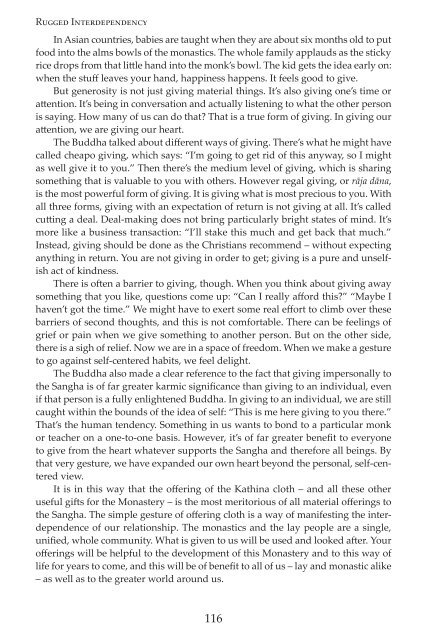Rugged Interdependency - Amaravati Buddhist Monastery
Rugged Interdependency - Amaravati Buddhist Monastery
Rugged Interdependency - Amaravati Buddhist Monastery
- No tags were found...
Create successful ePaper yourself
Turn your PDF publications into a flip-book with our unique Google optimized e-Paper software.
<strong>Rugged</strong> <strong>Interdependency</strong>In Asian countries, babies are taught when they are about six months old to putfood into the alms bowls of the monastics. The whole family applauds as the stickyrice drops from that little hand into the monk’s bowl. The kid gets the idea early on:when the stuff leaves your hand, happiness happens. It feels good to give.But generosity is not just giving material things. It’s also giving one’s time orattention. It’s being in conversation and actually listening to what the other personis saying. How many of us can do that? That is a true form of giving. In giving ourattention, we are giving our heart.The Buddha talked about different ways of giving. There’s what he might havecalled cheapo giving, which says: “I’m going to get rid of this anyway, so I mightas well give it to you.” Then there’s the medium level of giving, which is sharingsomething that is valuable to you with others. However regal giving, or rāja dāna,is the most powerful form of giving. It is giving what is most precious to you. Withall three forms, giving with an expectation of return is not giving at all. It’s calledcutting a deal. Deal-making does not bring particularly bright states of mind. It’smore like a business transaction: “I’ll stake this much and get back that much.”Instead, giving should be done as the Christians recommend – without expectinganything in return. You are not giving in order to get; giving is a pure and unselfishact of kindness.There is often a barrier to giving, though. When you think about giving awaysomething that you like, questions come up: “Can I really afford this?” “Maybe Ihaven’t got the time.” We might have to exert some real effort to climb over thesebarriers of second thoughts, and this is not comfortable. There can be feelings ofgrief or pain when we give something to another person. But on the other side,there is a sigh of relief. Now we are in a space of freedom. When we make a gestureto go against self-centered habits, we feel delight.The Buddha also made a clear reference to the fact that giving impersonally tothe Sangha is of far greater karmic significance than giving to an individual, evenif that person is a fully enlightened Buddha. In giving to an individual, we are stillcaught within the bounds of the idea of self: “This is me here giving to you there.”That’s the human tendency. Something in us wants to bond to a particular monkor teacher on a one-to-one basis. However, it’s of far greater benefit to everyoneto give from the heart whatever supports the Sangha and therefore all beings. Bythat very gesture, we have expanded our own heart beyond the personal, self-centeredview.It is in this way that the offering of the Kathina cloth – and all these otheruseful gifts for the <strong>Monastery</strong> – is the most meritorious of all material offerings tothe Sangha. The simple gesture of offering cloth is a way of manifesting the interdependenceof our relationship. The monastics and the lay people are a single,unified, whole community. What is given to us will be used and looked after. Yourofferings will be helpful to the development of this <strong>Monastery</strong> and to this way oflife for years to come, and this will be of benefit to all of us – lay and monastic alike– as well as to the greater world around us.116
















